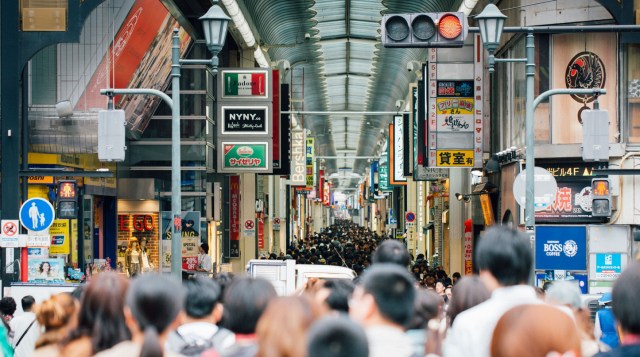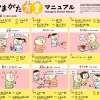
Startling photos have everyone concerned about a possible new spike in coronavirus cases.
Ever since May, when the Japanese Prime Minister declared a state of emergency and asked people to stay home as much as possible to help contain the coronavirus pandemic, public holidays and long weekends have come and gone with people cancelling trips to stay inside their homes instead.
However, that all seemed to change this week, as Respect for the Aged Day and Autumnal Equinox Day fell on Monday and Tuesday respectively, creating a four-day weekend just as the worst of the stifling summer heat tailed off, bringing about the perfect conditions for travel.
And travel is what people have been doing, with news reports saying there’s been a 249.1-percent increase in travellers to Arashiyama in Kyoto, and increased numbers at other tourist hotspots like Hakone in Kanagawa (109.4 percent), Atami Onsen in Shizuoka (57.6 percent), and Otaru in Hokkaido (54.2 percent).
「4連休3日目 都内には多くの人…渋滞も」
— aoi@stayhome (@aoistayhome) September 21, 2020
京都…前週比249%増💦https://t.co/aG4jvaKObY pic.twitter.com/K92ztBYdf6
The roads were jammed with traffic near a lot of tourist spots, particularly in onsen towns, like this one at Jozankei, an onsen town near Sapporo in Hokkaido.
大ーーーーーー渋滞!
— ジュンジュン☆ (@happy75_) September 21, 2020
いつになったら目的地に着けるだろうか#定山渓 pic.twitter.com/FMO2BDWNnY
To give you an idea of how many cars were on the roads, there was a 60-kilometre-long traffic jam from Nishishinjuku in Tokyo to Uenohara in Yamanashi Prefecture, located 61 kilometres (38 miles) away.
渋滞60キロってなんだよ、ギャグか? pic.twitter.com/p5Thu6HAs1
— いち (@01Ichi) September 21, 2020
Yamanashi Prefecture is home to one half of Mt Fuji (as it lies on the boundary between Yamanashi and Shizuoka prefectures), and it’s also famous for Hottarakashi Onsen, which had a line of people waiting to get in.
https://twitter.com/sub72_gt/status/1307972756194041856▼ The massive spike in visitors was recorded on Google.
ヒェ! pic.twitter.com/BdXhadiSGX
— スミソ@バサスロ (@sumiso03) September 21, 2020
At Universal Studios Japan, in Osaka, the park became so full they had to restrict entry, with people lining up for two hours to get in.
▼ This was the crowd waiting to enter the park when it opened at 8 a.m.
オープン8時直前です❗️
— ぱりんこっこ (@J5gnbYq) September 20, 2020
#USJ pic.twitter.com/6SUX3B9Hw6
Mt Takao, a popular hiking spot near Tokyo, was similarly crowded, with queues forming on the forest trails when emergency services were called to transport an injured hiker to hospital.
高尾山山頂
— ひまひま®︎ (@hima_2seijin) September 21, 2020
人が多すぎだろ pic.twitter.com/pvzuCRB52z
高尾山6号路、負傷者搬送で渋滞しておりますー(ノД`) pic.twitter.com/s9TvD4Xa57
— 岬 の マ チ コ (@machikovsky) September 21, 2020
A lot of people were drawn to the great outdoors, with Raichosawa Camping Ground in Tateyama, Toyama Prefecture, packed with visitors.
現在 9/20 16時の雷鳥沢キャンプ場の状況です。
— すぎやま もちやす (@sugibon1) September 20, 2020
キャパオーバーですね。明朝のトイレ渋滞が恐ろしいです。
#雷鳥沢キャンプ場#過密キャンプ場 pic.twitter.com/hFaAEjO7hH
▼ This was the line to use the toilets at the campground.
朝も大渋滞ですw pic.twitter.com/cvkIOdp8MG
— Ryoubi TARUTARU (@tryouichi) September 20, 2020
Even Nagano’s remote highland valley Kamikochi had its tranquil surroundings interrupted by throngs of visitors, who queued for two hours to board the shuttle bus to the carpark.
最後の力を振り絞って涸沢カールから下山!15時15分のバスを目指して頑張って歩いたのに、さわんど駐車場シャトルバスがまさかの2時間待ち#上高地#上高地バスターミナル#混雑#シルバーウィークの洗礼 pic.twitter.com/2Zu4hqZ27M
— まさ太郎 (@YamaNote_com) September 21, 2020
One of the worst places turned out to be the Kodomonokuni theme park located in Yokohama, just outside of Tokyo.
今からの こどもの国 来園はオススメしません。電車激混みで車は渋滞で動きません。地元住民より。#こどもの国 pic.twitter.com/whhGX8a42l
— ちょろ@恩田畦道 (@suga_yanyan) September 21, 2020
▼ The park was so packed it appeared on television reports.
こどもの国ふたたび pic.twitter.com/UTpajBxXvt
— 定住民 (@imin8_19) September 22, 2020
▼ Trains were so crowded one Twitter user likened it to Comiket in Tokyo.
こどもの国線大混雑すぎてワロタ pic.twitter.com/mVOAPgKnIZ
— ほえおか (@bawlhorkr07) September 21, 2020
コミックマーケット2020秋
— 定住民 (@imin8_19) September 21, 2020
inこどもの国 pic.twitter.com/g8eF4bA3Vo
While new coronavirus cases in Japan have this week dropped to below 500 — lower than the first spike seen in April, when 743 cases were recorded, and early August, when there were 1,998 new cases — the pandemic is far from over, and people are now concerned that the widespread weekend travel will result in another spike.
“Um, did I miss something? Is the pandemic over??”
“It’ll be scary to see what the numbers are like in two weeks’ time…”
“Roadside rest stations are also filled with people visiting from outside the prefecture.”
“There’s no sense of crisis here because the number of COVID-19 cases is less than other countries.”
“Why the heck would you want to spend your holidays stressed out in big crowds?”
“I work at a cafe in a local tourist area, and today was the busiest day of the whole year.”
While people are rightly concerned about the crowds of people gathering together, often outside of their home prefectures, local businesses and the government will no doubt be pleased to see people travelling.
It’s exactly what the government’s Go To campaign was aiming for — providing travel subsidies to the public to get them moving and spending to help the economy during the pandemic. Whether or not this will have a detrimental effect on the national health system, however, is yet to be seen.
Source: Jin
Featured image: Pakutaso
● Want to hear about SoraNews24’s latest articles as soon as they’re published? Follow us on Facebook and Twitter!

 Mt. Fuji is officially closed for the year
Mt. Fuji is officially closed for the year Barricades placed on Mt. Fuji as mountain officially closes because of coronavirus【Video】
Barricades placed on Mt. Fuji as mountain officially closes because of coronavirus【Video】 Huge crowds gather for Halloween in Japan despite calls to stay home【Photos】
Huge crowds gather for Halloween in Japan despite calls to stay home【Photos】 Hiking restrictions result in huge drop in climbing accidents, with zero on Mt. Fuji
Hiking restrictions result in huge drop in climbing accidents, with zero on Mt. Fuji New GU Pokémon collaboration: Worth the risk of catching coronavirus?
New GU Pokémon collaboration: Worth the risk of catching coronavirus? Seaside scenery, history, and so many desserts on Yokohama’s Akai Kutsu【Japan Loop Buses】
Seaside scenery, history, and so many desserts on Yokohama’s Akai Kutsu【Japan Loop Buses】 Foreigner’s request for help in Tokyo makes us sad for the state of society
Foreigner’s request for help in Tokyo makes us sad for the state of society Red light district sushi restaurant in Tokyo shows us just how wrong we were about it
Red light district sushi restaurant in Tokyo shows us just how wrong we were about it Japanese city loses residents’ personal data, which was on paper being transported on a windy day
Japanese city loses residents’ personal data, which was on paper being transported on a windy day Harajuku Station’s beautiful old wooden building is set to return, with a new complex around it
Harajuku Station’s beautiful old wooden building is set to return, with a new complex around it Starbucks Japan adds a Motto Frappuccino to the menu for a limited time
Starbucks Japan adds a Motto Frappuccino to the menu for a limited time Japan’s new wearable air conditioner belt is here just in time for the Tokyo heat wave
Japan’s new wearable air conditioner belt is here just in time for the Tokyo heat wave Akihabara pop-up shop sells goods made by Japanese prison inmates
Akihabara pop-up shop sells goods made by Japanese prison inmates Japan’s massive matcha parfait weighs 6 kilos, contains hidden surprises for anyone who eats it
Japan’s massive matcha parfait weighs 6 kilos, contains hidden surprises for anyone who eats it North Japan prefecture creates guide to help new foreign workers understand local language quirks
North Japan prefecture creates guide to help new foreign workers understand local language quirks McDonald’s new Happy Meals offer up cute and practical Sanrio lifestyle goods
McDonald’s new Happy Meals offer up cute and practical Sanrio lifestyle goods Japanese ramen restaurants under pressure from new yen banknotes
Japanese ramen restaurants under pressure from new yen banknotes French Fries Bread in Tokyo’s Shibuya becomes a hit on social media
French Fries Bread in Tokyo’s Shibuya becomes a hit on social media Studio Ghibli releases new action figures featuring Nausicaä of the Valley of the Wind characters
Studio Ghibli releases new action figures featuring Nausicaä of the Valley of the Wind characters New private rooms on Tokaido Shinkansen change the way we travel from Tokyo to Kyoto
New private rooms on Tokaido Shinkansen change the way we travel from Tokyo to Kyoto Tokyo Tsukiji fish market site to be redeveloped with 50,000-seat stadium, hotel, shopping center
Tokyo Tsukiji fish market site to be redeveloped with 50,000-seat stadium, hotel, shopping center All-you-can-drink Starbucks and amazing views part of Tokyo’s new 170 meter-high sky lounge
All-you-can-drink Starbucks and amazing views part of Tokyo’s new 170 meter-high sky lounge Beautiful Ghibli sealing wax kits let you create accessories and elegant letter decorations【Pics】
Beautiful Ghibli sealing wax kits let you create accessories and elegant letter decorations【Pics】 Studio Ghibli releases Kiki’s Delivery Service chocolate cake pouches in Japan
Studio Ghibli releases Kiki’s Delivery Service chocolate cake pouches in Japan New definition of “Japanese whiskey” goes into effect to prevent fakes from fooling overseas buyers
New definition of “Japanese whiskey” goes into effect to prevent fakes from fooling overseas buyers Our Japanese reporter visits Costco in the U.S., finds super American and very Japanese things
Our Japanese reporter visits Costco in the U.S., finds super American and very Japanese things Studio Ghibli unveils Mother’s Day gift set that captures the love in My Neighbour Totoro
Studio Ghibli unveils Mother’s Day gift set that captures the love in My Neighbour Totoro More foreign tourists than ever before in history visited Japan last month
More foreign tourists than ever before in history visited Japan last month New Pokémon cakes let you eat your way through Pikachu and all the Eevee evolutions
New Pokémon cakes let you eat your way through Pikachu and all the Eevee evolutions Sales of Japan’s most convenient train ticket/shopping payment cards suspended indefinitely
Sales of Japan’s most convenient train ticket/shopping payment cards suspended indefinitely Sold-out Studio Ghibli desktop humidifiers are back so Totoro can help you through the dry season
Sold-out Studio Ghibli desktop humidifiers are back so Totoro can help you through the dry season Japanese government to make first change to romanization spelling rules since the 1950s
Japanese government to make first change to romanization spelling rules since the 1950s Ghibli founders Toshio Suzuki and Hayao Miyazaki contribute to Japanese whisky Totoro label design
Ghibli founders Toshio Suzuki and Hayao Miyazaki contribute to Japanese whisky Totoro label design Doraemon found buried at sea as scene from 1993 anime becomes real life【Photos】
Doraemon found buried at sea as scene from 1993 anime becomes real life【Photos】 Tokyo’s most famous Starbucks is closed
Tokyo’s most famous Starbucks is closed One Piece characters’ nationalities revealed, but fans have mixed opinions
One Piece characters’ nationalities revealed, but fans have mixed opinions We asked a Uniqlo employee what four things we should buy and their suggestions didn’t disappoint
We asked a Uniqlo employee what four things we should buy and their suggestions didn’t disappoint Princesses, fruits, and blacksmiths: Study reveals the 30 most unusual family names in Japan
Princesses, fruits, and blacksmiths: Study reveals the 30 most unusual family names in Japan Human traffic jam on Mt. Fuji shows why weekdays are the best days to hike the symbol of Japan
Human traffic jam on Mt. Fuji shows why weekdays are the best days to hike the symbol of Japan Japanese train station grows wine grapes on the platform
Japanese train station grows wine grapes on the platform Strong earthquake hits Hokkaido in Japan, dozens missing and injured
Strong earthquake hits Hokkaido in Japan, dozens missing and injured Typhoon Faxai strands thousands at Narita Airport in Japan【Pics & Video】
Typhoon Faxai strands thousands at Narita Airport in Japan【Pics & Video】 Tokyo Disneyland and Disney Sea will close for two weeks because of coronavirus fear
Tokyo Disneyland and Disney Sea will close for two weeks because of coronavirus fear Chewbacca and Darth Vader show up in the mountains of Japan thanks to cosplaying outdoorsman
Chewbacca and Darth Vader show up in the mountains of Japan thanks to cosplaying outdoorsman Hilariously mundane cosplays from “Jimi Halloween” 2020 in Tokyo【Photos】
Hilariously mundane cosplays from “Jimi Halloween” 2020 in Tokyo【Photos】 Japanese yokai starts appearing on Twitter to prevent the spread of COVID-19
Japanese yokai starts appearing on Twitter to prevent the spread of COVID-19 Mayhem at Uniqlo in Japan as customers fight to grab the Jil Sander collection
Mayhem at Uniqlo in Japan as customers fight to grab the Jil Sander collection Nearly half of survey respondents in Japan feel healthier since before COVID-19
Nearly half of survey respondents in Japan feel healthier since before COVID-19 Mt. Fuji is now open again following 2020 shutdown
Mt. Fuji is now open again following 2020 shutdown Breaking: Japanese Prime Minister finally takes a day off after 148-day work streak
Breaking: Japanese Prime Minister finally takes a day off after 148-day work streak Iconic Kyoto Tower bathhouse closes due to coronavirus
Iconic Kyoto Tower bathhouse closes due to coronavirus One of Tokyo’s best hot spring complexes is closing for good
One of Tokyo’s best hot spring complexes is closing for good
Leave a Reply